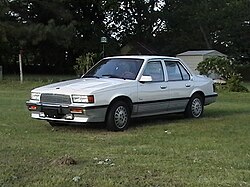Cadillac Cimarron
| Cadillac Cimarron | |
|---|---|
 | |
| Overview | |
| Manufacturer | General Motors |
| Production | 1982–1988 |
| Assembly | Janesville, Wisconsin Southgate, California |
| Body and chassis | |
| Class | Compact |
| Body style | 4-door sedan |
| Platform | FF J-body |
| Related | Buick Skyhawk Chevrolet Cavalier Oldsmobile Firenza Pontiac J2000 Pontiac 2000 Pontiac Sunbird |
| Powertrain | |
| Engine | 1.8 L OHV I4 2.0 L OHV I4 2.8 L 60° V6 |
The Cadillac Cimarron was a compact car built by Cadillac based on the GM J platform. It was first introduced in 1981 for the 1982 model year, and sold through 1988.
The Cimarron was one of Cadillac's least successful models, its noticeable economy car roots were seen by many automotive writers and critics as doing much to tarnish Cadillac's prestige image. According to Car and Driver, current Cadillac product director John Howell has a picture of the Cimarron on his wall captioned, "Lest we forget."[1]
History
Cadillac's first foray into smaller cars, the 1975 Cadillac Seville, intended to answer the sales threat from Mercedes-Benz luxury cars, was a relative success, but the political and economic climate of the 1980s suggested a need for something smaller. A crucial factor was the advent of CAFE (Corporate Average Fuel Economy) requirements from the U.S. federal government, which severely penalized automakers if their fleet average fuel economy dropped below the minimum. Another was the success of imported compacts from BMW, Mercedes-Benz, and Audi. Although Cadillac had intended to introduce the Cimarron later in the 1980s, it was rushed into production early. The result was the smallest and, in many opinions, least-distinguished Cadillac model produced to date.
GM had just introduced the J platform, an economy car platform shared across all passenger-car divisions. Each rode the same 101.2 in (2,570 mm) wheelbase and had the same basic MacPherson strut front suspension and torsion beam rear suspension, and all shared the same engines. The cars were mostly identical, however differed largely in styling details, features, and price. The basic body/frame structure used a unibody with a front subframe that carried the lower front suspension, engine, and transmission. This was refined for the Cimarron with the addition of hydraulic dampers between the subframe and the body in the interest of improving the ride and handling of the vehicle.
Pete Estes, GM's president at the time, warned Ed Kennard, Cadillac's general manager that "Ed, you don't have time to turn the J-car into a Cadillac."[2]
The Cimarron, introduced on May 21, 1981, was initially advertised as "Cimarron, by Cadillac."
The new compact Cadillac had the unconventional I4 engine (the first 4-cylinder Cadillac since 1914) and a four-speed manual transmission (Cadillac's first manual since 1953), with a three-speed Turbo-Hydramatic optional. Power steering and air conditioning were standard. The high level of standard equipment pushed base price to US$12,181, nearly double that of its J-body siblings.
While some motoring press critics had high praise for the car, it was coolly received by Cadillac buyers, and first-year sales were only 25,968, about a third what Cadillac anticipated. The Cimarron's compact dimensions did not appeal to traditional Cadillac buyers, and its humble origins did little to appeal to the buyers of high-priced imports. Consumers also thought it was absurd to pay twice as much for what essentially was a well-equipped Chevrolet Cavalier with Cadillac emblems, and thought General Motors should have developed a compact model specifically for Cadillac. Even though interior fabrics and craftsmanship were top notch, the Cimarron was further criticized for its standard four-cylinder engine (though a V6 engine arrived in 1985 and became standard in 1987). Critics derisively referred to it as the "Cadvalier".
Even though the Cimarron had grown comparatively more refined by the end of its production run with more Cadillac-like styling to further distinguish it from other J-cars, buyers stayed away, and the car was discontinued after 1988 with a production run that year of only 6,454 units. The Cimarron's failure was part of a series of events that drove the division close to bankruptcy in the 1980s, and Cadillac had little more luck with its next effort at a rebadged smaller car, the Catera.
References
- ^ Hutton, Ray, 2006 Cadillac BLS, Car and Driver, June 2006
- ^ Bonsall, Thomas E., [1], Trouble In Paradise: The Story of the Cadillac Cimarron, rideanddrive.com (via Wayback Machine)
